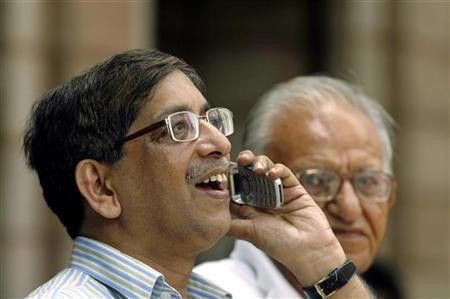Consolidation No Panacea for Indian Mobile Returns

Everyone knows that industry consolidation leads to improved shareholder returns. India's mobile market may be the exception. Revocation of 2G licences and now a change in M&A rules are expected to force a long-awaited deal frenzy in this challenging sector. But more concentration won't necessarily boost Indian mobile's famously poor margins. Just look at how a new giant-killer is challenging the dominance of the Big Three operators.
A man speaks on a phone as he looks at a large screen displaying India's benchmark share index on the facade of the Bombay Stock Exchange (BSE) building in Mumbai
Overcrowding has savaged profitability. After rapid growth, the sector seems to be maturing and new customers are hard to come by. While the top firms continue to turn a profit, the trend since 2008 has been a steady decline. Reliance Communications (RComm) reported a tenth consecutive quarterly drop in earnings in its most recent financial quarter; Bharti Airtel's (BRTI.NS) have fallen for the last eight quarters. Reliance's average revenue per user is now a mere $2.02 per month - down from $7.63 in 2008.
And yet the market still rewards savvy new entrants. Consider Idea Cellular, controlled by the Aditya Birla group (ABRL.NS). An also-ran two years ago, it has overtaken RComm as the number three player by revenue. Strong branding and a focus on second-tier cities and rural areas explain its rise. Idea is the only firm to have grown revenue in every quarter since 2010 and in December it added more subscribers than any other player. The so-called Big Three operators, which also include Vodafone (VOD.L), are now effectively a Big Four.
Consumers remain highly price sensitive. Bharti's recent disappointing quarterly results came on the back of attempts to push prices up. So it's not clear that cutting the market from 15 players to say even six or seven will have a dramatic effect on firms ability to raise tariffs. Regardless of whether expected consolidation takes place at the smaller end of the sector, competition will remain stiff and returns dampened.
Alliances among the really big players might make a difference. But the longer-term attractions of the market mean that no one player will want to pull back only to hand future benefits to rivals. At present, revenue from voice makes up almost 95 percent of the sector's revenue. Advanced markets tend to see more than one third of their revenue from data. As per-capita incomes rise in India, increasing higher value-added services is the most likely way of reversing the decline. But the payback still looks some way off.
CONTEXT NEWS
- India will allow mergers and acquisitions in the telecoms sector that create combined market share of up to 35 percent, under a quick and simple process, Telecoms Minister Kapil Sibal said on February 15. The sector regulator has proposed a relaxation of rules for M&A to facilitate a consolidation in the 15-player market.
- The Supreme Court earlier this month ordered all 122 zonal telecoms licences given to companies in a scandal-tainted 2008 sale be revoked in four months and asked the regulator to propose rules for granting spectrum through an auction.
- In the third quarter ending December 2011, revenues at the four leading mobile firms rose by 5 percent from the previous quarter. Idea Cellular, majority owned by the Aditya Birla group, posted the strongest increase in revenue. The firm grew by 9 percent on a quarter on quarter basis as compared with 4 percent for the market leader, Bharti Airtel, 5 percent for Vodafone's India business and 0.7 percent for Reliance Communications.
© Copyright Thomson Reuters {{Year}}. All rights reserved.





















